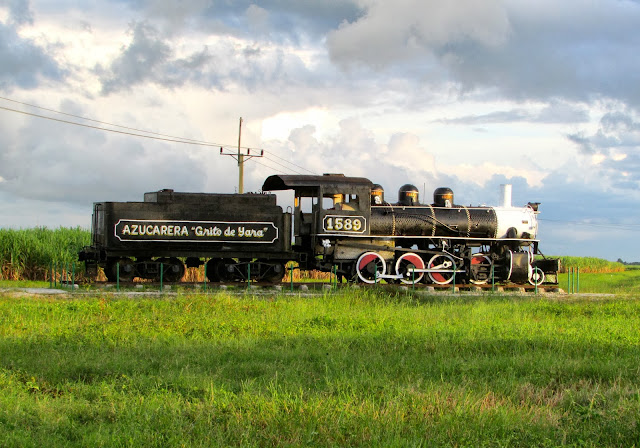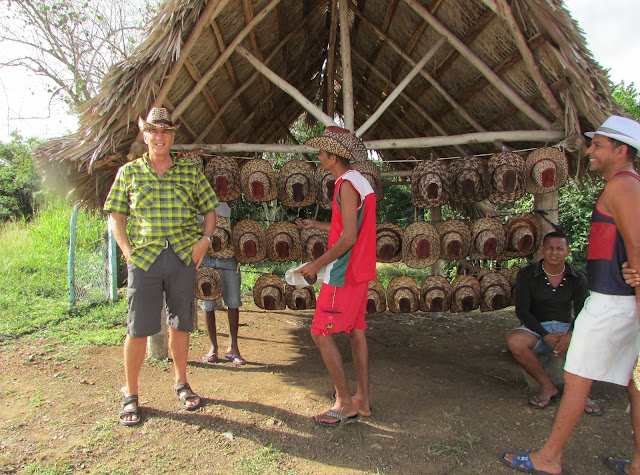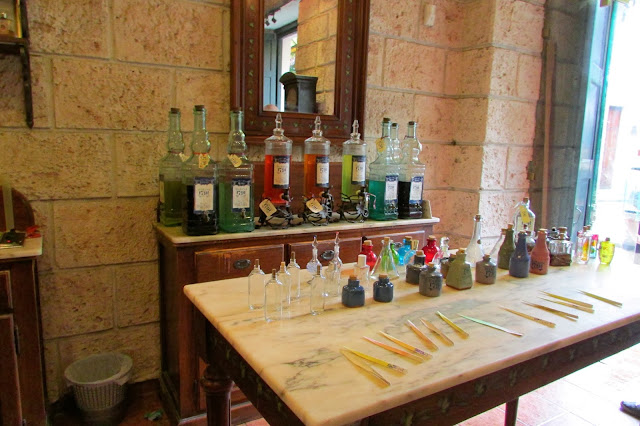Life on the road.
These plants like being high and wired.
En route to Las Tunas we stop for lunch and a quick look at Bayamo. We intend to stay the night but find out that it is the town's 500-year anniversary and big celebrations are underway and hotels are sold out.
Parque Céspedes in the center of town is one of Cuba's leafiest and friendliest squares, and the birthplace of the man himself—Carlos Manuel de Céspedes, hero of the First War of Independence. Despite its easygoing airs and secondary role as the city's best outdoor music venue, the square is loaded with historical significance. In 1868 Céspedes proclaimed Cuba's independence for the first time in front of the columned city hall. His bronze statue graces the square.
The engine of an old sugar cane train. As synonymous with Cuba as Che Guevara or Havana Club rum, sugarcane was first introduced onto the island by the Spanish in the early 1500s.
The market went boom and bust several times and these days Cuba produces a modest 2.5 million tonnes of sugar a year, and thanks to foreign competition, antiquated production techniques and the massive growth of the tourist economy, skeletal factories stand as soot-stained reminders of another era.
We drive on and spend the night in Las Tunas across from the Parque Vincente Garcia and San Jerónimo Catholic Church dating to 1790.
Every Cuban cowboy needs a sombrero. Tim buys one from a roadside stand for a whopping $2 (way too much) in the hopes it will make him look like a local to stave off those persistent
jineteros (hustlers). See his tips about Cuba's two-tiered economy at the end of our post titled,
"Mildewed Magnificence".
Let's face it. Some of the best places in Cuba are its beaches so we're bound for Cayo Guillermo for a few days of over-indulgence at the all-inclusive (again). Situated in the archepelageo of Jardines del Rey, Cayo Coco is Cuba's fourth largest island and the main tourist destination after Veradero. Since 1988 it has been connected to the mainland by a 27km causeway slicing across the Bahía de Perros.
Once on Cayo Coco another causeway takes us to Cayo Guillermo—haunt of pink flamingos, stunning blonde beaches and Cuba's second-most famous Ernesto after Mr. Guevara—Señor Hemingway. It was Hemingway who initiated Guillermo's early publicity drive, describing it radiantly in his posthumously published novel,
Islands in the Stream.
The mangroves off the south coast are home to pink flamingos and pelicans and there's a tremendous diversity of tropical fish and crustaceans on the Atlantic reef.
Unfortunately we arrive on the day a cold front blows in but the beach at nearby Playa Pilar is still sublime.
Playa Pilar is regularly touted as Cuba's—and the Caribbean's—greatest beach. Pilar's claim rests on two lofty pillars. First, there's the diamond dust white sand, so fine that if you drop a handful, it will blow away rather than hit the ground (or so say the locals). Second, there are the rugged 15m-high sand dunes (the largest of their kind in the Caribbean) strafed by rough trails that incite piratical exploration.
We get up today to find the storm has littered the normally pristine beach with seaweed. No problema, after almost three weeks in Cuba we've come to expect the unexpected so it's all good. We find a couple of beach loungers and settle in for the day.
Ahhh, all-inclusive heaven.
This eagle, hanging out at the outdoor restaurant, likes the all-inclusivo experience too.
Re-energized after four days on the playa we're on our way to Santa Clara via one of Cuba's oldest settlements, the city of Remedios.
Sedate Remedios erupts each December for one of the wildest street parties in the Caribbean, the legendary Las Parrandas, in which exuberant citizens take sides and face off against each other with floats, fireworks and dancing competitions. Founded sometime between 1513 and 1524, the city (when it isn't parrandas-ing) is a relaxed, resplendent place. We stop for lunch at Encanto's Hotel Mascotte and walk around town.
One of the island's finest ecclesiastical buildings, the Parroquia de San Juan Bautista church, dates from the late 18th century.
Che city (Santa Clara) has long been hallowed turf for hero-worshipping, beret-wearing Guevara buffs, but away from the bombastic monuments the city pulsates with a vitality which includes some of the country's most eclectic nighttime entertainment outside Havana. Here the billboard message from Fidel reads, “...we want them to be like Che”.
The Monumento Ernesto Che Guevara is in a vast square spanning both sides of the
carretera, guarded by a bronze statue of El Che. The statue was erected in 1987 to mark the 20th anniversary of Guevara's murder in Bolivia.
Few 20th-century figures have successfully divided public opinion as deeply as Ernesto Guevara de la Serna, better known to his friends (and enemies) as El Che. He has been revered as an enduring symbol of Third World freedom and celebrated as the hero of the Sierra Maestra, and yet Che was also the most wanted man on the CIA hit list. He was a handsome Argentine Marxist revolutionary, physician, author, guerrilla leader, diplomat and military theorist and a major figure of the Cuban revolution.
We go local again by staying in another Casa Particular (this one is Hostal Florida Center). Casa Particulares are private rooms in private houses and a great way to meet locals on their home turf. Staying in these venerable family-oriented establishments gives us a far more open and less censored view of the country, and our understanding and appreciation of Cuba. They're a bit rustico for us but at $20-25/night the price can't be beat as well as the hospitality.
Dinner is served in the courtyard restaurant of Hostal Florida, a few steps from our bedroom, where the attentive propriator, Angel, sees to our every need.
We've eaten a lot of flan in Cuba and for the most part it's been pretty good, including this one on the menu at Hostal Florida.
We stop to read this entertaining series of comic book-style murals with a tongue-in-cheek look at Cuban-American relations as the predominant theme.
Sombrero-wearing
guajiros saunter home on horseback after a tough day in the tobacco fields; rocking chairs creak on well-swept porches; cigar-sucking farmers navigate oxen through tilling the rich, red fields that roll around town; climbers tackle the sheer, forest-fringed
mogotes that shoot up beyond; we have arrived in Viñales, hub of what many reckon on being Cuba's most mesmerizing spot of scenery. Well established on the standard tourist circuit, this is where travelers come to relax, ruminate and revel in the great outdoors.
We wanted to stay here, at Hotel los Jazmines with its incredible views of the valley, but hoards of like-minded tourists beat us to it and it was booked solid.
Well, this isn't too shabby as a second option. While Los Jazmines might edge the prize for the best view, it's sister hotel, La Ermita, takes top honours for architecture, interior furnishings and all-round services and quality (keep in mind this is Cuba). It's also a lot less frenetic, thanks to the absence of any tour buses. Somehow we land the best room in the place, corner Room 64.
This is just one side of the panoramic view from the balcony of our room.
Walking out of town 1km past pretty casas and tobacco farms we arrive at Finca (farm) Raúl Reyes, nestled beneath the mogotes.
This cutie is a Cuban Hutia, a species of rodent endemic to Cuba.
La Ermita Hotel is sold out on our second night and we are forced to take this small, stuffy room with no windows in a Casa Particular in town. At this moment Tim is promising Sandi a fine meal at Elements when we get home to help her get through the night.
We hike to one of the many caves in the area.
An old, local farmer tells us his grandfather planted this tree and it is one of the oldest in the region.
Sr. Reyes, a very smart businessman, has a drink stand placed just where we (and every other tourist) needs it. We order a delicious cocktail of rum, pineapple juice and honey served in a semi-squashed grapefruit which comes with a bottle of rum that one can keep topping off one's drink with until one sees fairies.
Four kilometers west of Viñales village is a 120m-long painting designed in 1961. On a cliff at the foot of the 617m-high Sierra de Viñales, the highest portion of the Sierra de los Órganos, this massive mural took 18 people four years to complete. The huge snail, dinosaurs, sea monsters and humans on the cliff symbolize the theory of evolution and are either impressively psychedelic or monumentally horrific, depending on your point of view.
The Cueva de San Miguel north of town, is a gaping cave that engulfs you while you sip your rum and pineapple juice. At night it's a nightclub that rocks in the wee hours in the morning.
Back in town we dine at Restaurante la Casa de Don Tomás said to be the best place in town, but guess what? It isn't.
The music makes up for the food and we leave with these guys’ CD to add to our growing collection. The musica de Cubana tops of our list of best things about the country. It's everywhere and it's all incredibly good.
Farm equipment is expensive and in short supply so farmers have gone back to the reliable methods of yesteryear—the trusty ox and plough. It's a lot slower but one thing Cubans have is a lot of time.
Roads are used to dry rice so Tim has to be careful to drive around it.
The pioneering eco-village of Las Terrazas dates back to a reforestation project in 1968. Today it's a Unesco Biosphere Reserve, a burgeoning activity center and the site of the earliest surviving coffee plantations in Cuba. Not surprisingly, it attracts day-trippers from Havana by the busload.
Starbucks Cuban-style is found at Patio de Maria. The beans are grown about 20km away from your cup in front of the airy terrace. Beat that Howard.
We hike to a scenic spot where we see the town nestled into the side of the mountain.
We wander around the restored ruins of Cuba's oldest coffee plantation, Cafetal Buenavista, built in 1801 by French refugees from Haiti. The huge tajona (grindstone) once extracted the coffee beans from their shells. Next the beans were sun-dried on huge platforms. Ruins of the quarters of some of the 126 slaves held here can be seen alongside the driers.
Tim fills up at the quirky 1950s-style Esso station (the ‘T’ in EssTo apparently stands for Terrazas).
About 3.5km west of town the Hacienda Unión is another partially reconstructed coffee-estate ruin.
A roadside distraction we can't resist stopping for. Señora Puerco and her seven adorable puercoitos.
On our way back we notice a lone piglet but no sign of Mrs. Puerco and the others so Sandi goes on a mission to try to find and reunite them.
We're staying at Hotel Moka, Cuba's only real eco-hotel. It might not qualify for the four stars it advertises, but who's arguing? With its trickling fountains, blooming flower garden and resident tree growing through the lobby, Moka would be a catch in any country.
We end our tour of Cuba where we began, in Havana. With a day left to go we try to see a few of the things we missed at the start like Habana 1791, a specialist shop on Calle Mercaderes that sells perfume made from tropical flowers.
Parque Guayasamin on Calle Mercaderes. We love the art of Oswaldo Guayasamin which we first discovered in Ecuador. He had a studio here and is famous for painting Fidel in numerous poses.
No tourist worth his salt can leave Havana without the token photos from the Plaza de la Revolución. The plaza was built on a small hill in the manner of Paris’ Place de Étoile, with various avenues fanning out in every direction. Surrounded by grey, utilitarian buildings constructed in the late 1950s, the square today is the base of the Cuban government and a place where large-scale political rallies are held. The Ministerio del Interior building is well known for its huge mural of Che Guevara with the words
Hasta la Victoria Siempre (Always Towards Victory) emblazoned underneath.
In 2009 a similarly designed image of Cuba's other heroic guerrillero, Camilo Cienfuegos, was added on the adjacent telecommunications building.
Center-stage is the Memorial a José Martí, which at 138.5m is Havana's tallest structure fronted by an impressive 17m marble statue of a seated Martí in a pensive
Thinker pose.
Tim spots something he likes... a bright red 1952 Cadillac and can't resist having a chat with it's owner. See his tips about driving in Cuba at the end of our last post titled,
"Onward to Victory".
It's a blustery day on the Malecón.
Despite the bad weather we head over to the Castillo de los Tres Santos Reyes Magnos del Morro. This imposing fort was erected between 1589 and 1630 to protect the entrance to Havana harbour from pirates and foreign invaders. Perched high on a rocky bluff above the Atlantic, the fort's irregular polygonal shape, 3m-thick walls and deep protective moat offer a classic example of Renaissance military architecture. For more than a century the fort withstood numerous attacks by French, Dutch, and English privateers, but in 1762, after a 44-day siege, a 14,000-strong British force capture El Morro by attacking form the landward side.




We give Cuba a final toast at historic Sloppy Joes Bar. That Cuba has survived is a miracle in itself. That it can still enthrall travelers from around the globe with its beaches, bays, mountains, rum, music, and impossibly verdant landscapes is an even greater achievement. The key lies in the Cubans themselves; survivors and improvisers, poets and dreamers, cynics and sages. Defying all logic, it is the people who have kept the country alive as the infrastructure has crumbled; and it is they also who have ensured that Cuba continues to be the fascinating, perplexing, paradoxical nation it is. Such uniqueness is a vanishing commodity in an increasingly globalized world. We're glad we grabbed it while it's still there.









































































































